MARIANI’SVirtual
Gourmet
September 9,
2012
NEWSLETTER
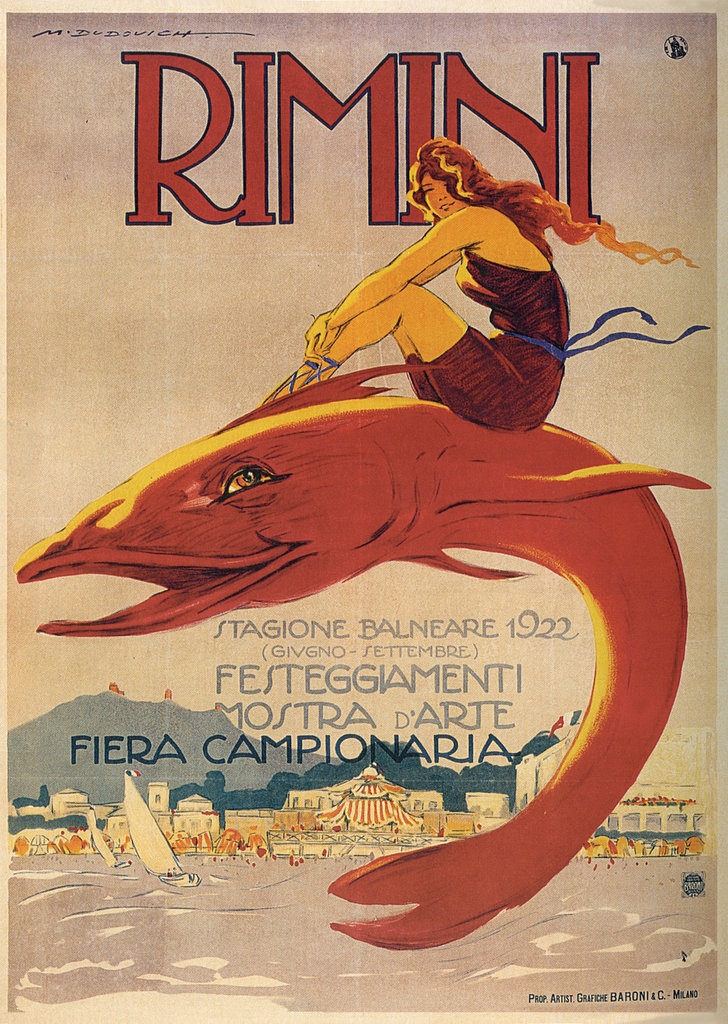
Rimini poster
by Marcello Dudovich, 1922
❖❖❖
THIS WEEK
Part Two
by Brian Freedman
NEW YORK CORNER
ROSEMARY'S
by John
Mariani
Greek Wines Soar as Greek Economy Sours
by John Mariani
❖❖❖
Sailing the Queen Elizabeth
Part Two: Into the Fjords
by Brian Freedman
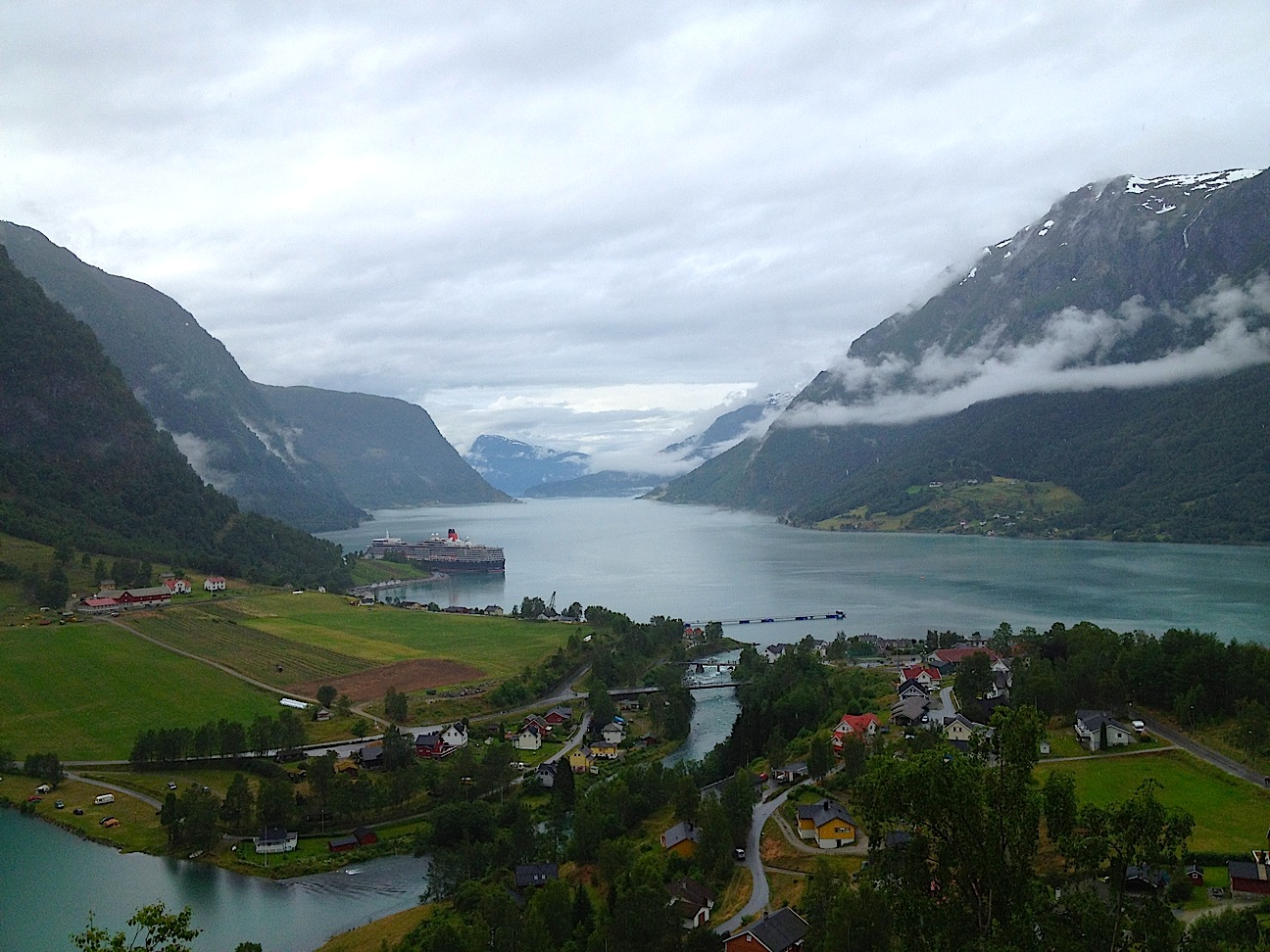
Skjolden, Norway
Readjusting to normal
life after a particularly enjoyable journey is always
difficult. The first day home, all those quotidian
annoyances that we had managed to avoid while
away--the bills, the laundry, the loud neighbors--seem
particularly onerous. And, indeed, the morning after
our flight landed in Philadelphia, after a week-long
cruise of Norway on Cunard’s Queen Elizabeth,
my wife and I struggled to internalize the fact that
there would be no smoked salmon at breakfast, no
choice of two types of bacon, no excursions to look
forward to beyond heading to the post office and
collecting the stacks of mail we’d missed.
But most surprising of all was how deeply we
missed the air in Norway. Over the course of four days
of shore excursions that ran the gamut from wandering
city streets to relatively strenuous kayaking trips,
one constant ran throughout it all: some of the best
air I’d ever breathed.
This first dawned on me as we awoke after our
second night onboard, navigating the fjords and
eventually pulling into port in the utterly gorgeous
city of Bergen, Norway’s second largest. Remarkably,
however, despite its size (the greater Bergen 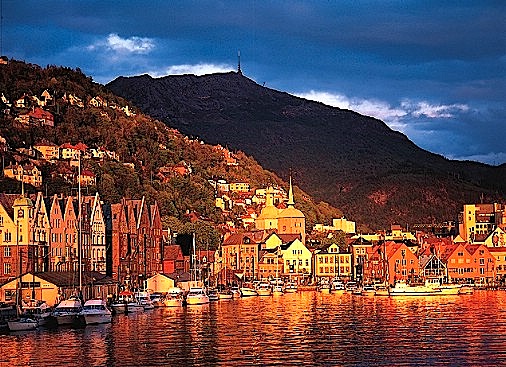 metro area is
home to more than 390,000 people), the city retains a
sense of quaintness, what we came to understand as a
uniquely Nordic balance of order, friendliness, and
respect. And the air--whether tinged with the heady
aroma of salmon and shrimp in the fish market or the
fresh dampness along the trails winding up the hills
on the city’s outskirts--spoke of the kind of clear,
ocean-touched cleanliness that seemed to be the
complete opposite of what I usually breathe in
Philadelphia.
metro area is
home to more than 390,000 people), the city retains a
sense of quaintness, what we came to understand as a
uniquely Nordic balance of order, friendliness, and
respect. And the air--whether tinged with the heady
aroma of salmon and shrimp in the fish market or the
fresh dampness along the trails winding up the hills
on the city’s outskirts--spoke of the kind of clear,
ocean-touched cleanliness that seemed to be the
complete opposite of what I usually breathe in
Philadelphia.
The city itself offers any number of
experiences, depending on what sort of adventure you
aim for. Fortunately, as with all the days when the Queen Elizabeth
was docked at our various ports of call, there was
ample time to experience a significant swath of them.
We began by finding our way to the funicular
for the ride up Mount Fløyen, at the top of
which, we’d heard, was supposed to be one of the best
views of the city. The line, however, stretched on for
longer than we cared to wait, and knowing that there’d
be plenty of food and leisure time back on board the
ship, we decided to climb most of the way up
ourselves.
It was a steep walk, but the surroundings
lessened the difficulty: The path wound its way
through collections of homes perched on hillsides that
made San Francisco look like rolling prairie, and
alongside forests as green and regal as any in Europe.
Every time we thought we couldn’t climb any more,
another local would come jogging by, sometimes in full
workout gear, sometimes pushing a stroller. So we
continued: Guilt is a powerful motivator in the
fitness realm.
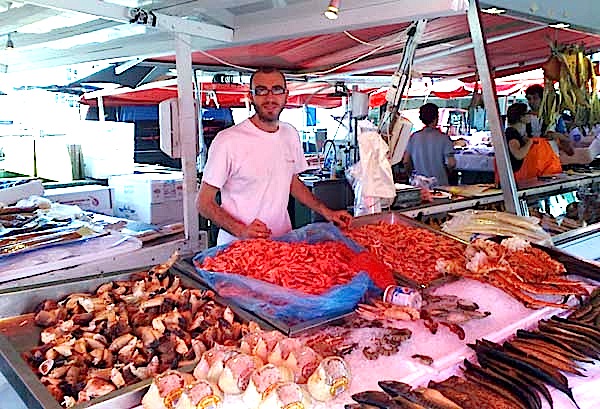 Just under an
hour later, winded and hungry but glad to have made
the trek--the view really was spectacular, the port
spread out below us, the city stretching out beyond,
all of it twinkling in the light from the sun off the
water--we decided to fuel up at the fish market, the fisketorget i
Bergen. Turns out you can spend hours there
alone: As far as the eye could see, bright salmon
glistened on display, the sellers offering muslin-thin
slices of it to taste, whether raw or cured or smoked.
Caviar of every size and shape and price, from
startlingly fresh wild orbs to tubes of caviar
squeezed out like a paste. Crab legs splayed and
tangled atop their ice, as if they were dancing.
Shrimp, either raw and luxuriating on the ice or
cooked and curled up atop bread for the famous
open-faced
smørbrød sandwiches of the
country. Berries and other fruits neatly displayed and
ready to burst. All of it could be prepared while you
waited: A deliriously fresh lunch, taken at
picnic-style tables, right there in the market with
the water lapping before us.
Just under an
hour later, winded and hungry but glad to have made
the trek--the view really was spectacular, the port
spread out below us, the city stretching out beyond,
all of it twinkling in the light from the sun off the
water--we decided to fuel up at the fish market, the fisketorget i
Bergen. Turns out you can spend hours there
alone: As far as the eye could see, bright salmon
glistened on display, the sellers offering muslin-thin
slices of it to taste, whether raw or cured or smoked.
Caviar of every size and shape and price, from
startlingly fresh wild orbs to tubes of caviar
squeezed out like a paste. Crab legs splayed and
tangled atop their ice, as if they were dancing.
Shrimp, either raw and luxuriating on the ice or
cooked and curled up atop bread for the famous
open-faced
smørbrød sandwiches of the
country. Berries and other fruits neatly displayed and
ready to burst. All of it could be prepared while you
waited: A deliriously fresh lunch, taken at
picnic-style tables, right there in the market with
the water lapping before us.
Sometimes, if you’re lucky, travel presents you
with opportunities to experience dishes that you’ve
never tasted before. When you have the chance, it’s a
shame to pass it up. Which is why I had a whale
sandwich for lunch that day.
Norway is one of only two
commercial whaling countries in the world. Iceland is
the other. Japan, which is associated with whaling,
ostensibly does so primarily for scientific reasons,
and only allows the meat to reach the market after
research on 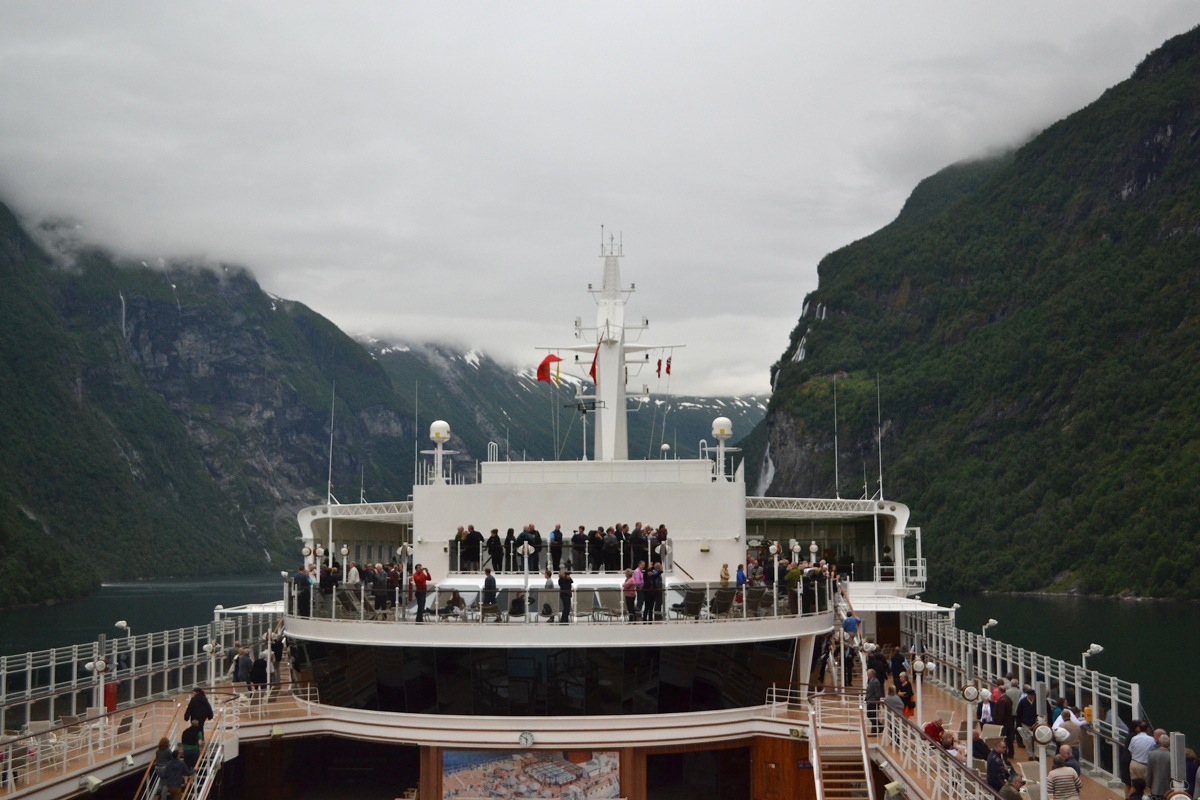 the animals is complete. Tucking into
the unexpectedly delicious whale meat is perfectly
legal in Norway, so when I saw the rows of whale
sausages, and the sandwiches of whale meat almost
black in the early-afternoon sun, I knew it’s what I’d
be eating.
the animals is complete. Tucking into
the unexpectedly delicious whale meat is perfectly
legal in Norway, so when I saw the rows of whale
sausages, and the sandwiches of whale meat almost
black in the early-afternoon sun, I knew it’s what I’d
be eating.
Good thing I tried it: It was easily one of the
most interesting sandwiches of my life. The flesh
itself was almost beefy, ringing with a distinct
minerality, and toothsome without being tough. Dragged
through a splash of local mustard, almost fruity
alongside its aromatics, this was a sandwich both
hearty and exotic, and thoroughly unlike anything I’d
tasted. It was also as evocative of that specific part
of the planet as anything I could have eaten that day:
A fantastic introduction to Norway.
We also enjoyed a platter of just-caught
salmon, grilled up with potatoes, vegetables, and
mushrooms. Hundreds of others joined us. The Babel of
languages, the fish-sellers hawking their meat, the
fruit vendors off to the side with their neat rows of
produce: What a perfect welcome this was.
Well-fed and ready to explore some more, we
wandered our way through the city, alongside the
multicolored Hanseatic buildings by the water, through
carefully planted flower gardens lining residential
streets, past homes as tidy and proud as you’d hope.
The balance that Bergen strikes between major modern
city and natural wonder is carefully calibrated and
beautifully managed.
Back on the ship and preparing to pull out of
port, I noticed a phenomenon that followed the Queen Elizabeth
everywhere she docked: Locals would line up alongside
her, waving and snapping photos, memorializing their
view of one of the most well-known liners in the
world. As we pulled out and began the journey to
Geiranger, our northernmost destination on the cruise,
birds flew alongside the ship, escorting us as we
sailed our way past islands and through the
crystalline air.
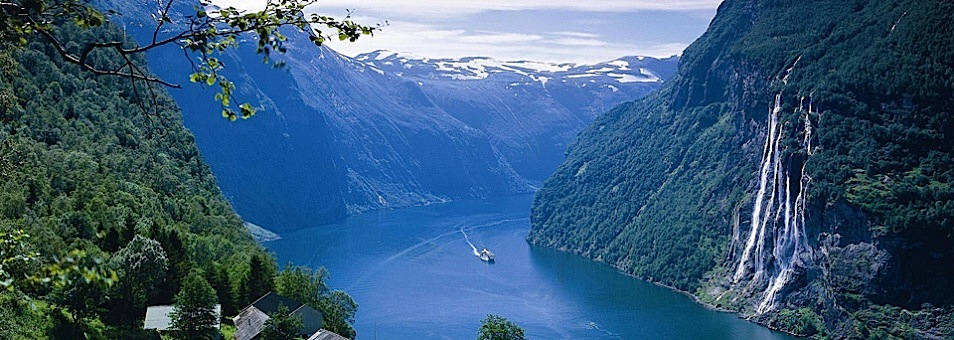 Geiranger
offered a completely different experience. The town
itself is home to fewer than 250 full-timers, but the
constant flow of tourist ships makes it a far busier
town than the numbers imply. We chose to experience it
on the water, participating in a kayaking expedition
that, we were told, ran to nearly six kilometers. Our
group of approximately 20 kayaks--most of them
outfitted for two--paddled past the ships dotting the
port, through the cool waters, and out to the Seven
Sisters Waterfall--yes, there are seven of them
clustered together, the tallest of which plummets more
than 800 feet. Between the sloshing of the water, the
lung-clearing air, and the overwhelmingly beautiful
scenery, I felt as if I were in some sort of
postcard-of-Norway come to life.
Geiranger
offered a completely different experience. The town
itself is home to fewer than 250 full-timers, but the
constant flow of tourist ships makes it a far busier
town than the numbers imply. We chose to experience it
on the water, participating in a kayaking expedition
that, we were told, ran to nearly six kilometers. Our
group of approximately 20 kayaks--most of them
outfitted for two--paddled past the ships dotting the
port, through the cool waters, and out to the Seven
Sisters Waterfall--yes, there are seven of them
clustered together, the tallest of which plummets more
than 800 feet. Between the sloshing of the water, the
lung-clearing air, and the overwhelmingly beautiful
scenery, I felt as if I were in some sort of
postcard-of-Norway come to life.
That afternoon, as the Queen was pulling out of
her berth and navigating the fjords, the decks filled
up with passengers, some keeping warm with the wool
blankets provided by the ship, others using cocktails
for similar ends, all of us transfixed by the
mountainsides we sailed past that seemed close enough
to grab hold of.
This natural beauty is part of so much of the
Norway experience, yet it never grows commonplace: The
grandeur of it all prevents that, the sheer magnitude
of it always stuns. The next day, we experienced
Skjolden not from the water, but from the land. (It
was the ship’s maiden call there, and the trips in and
out, along the longest fjord in the country, the
Sognefjord, were breathtaking.) This was our one rainy
day--not a constant one, thankfully, just occasional
showers--but the weather did nothing to dampen the
experience of hiking from the ship and up one of the
mountainsides, at the top of which was a view that, as
much as any, clarified the sheer size and scope of
Norway’s fjords. At one point on the hike we caught a
glimpse of the Queen
Elizabeth in the distance, and she was dwarfed
by the land, her regal, iconic wedge framed by the
almost incomprehensibly grand surroundings.
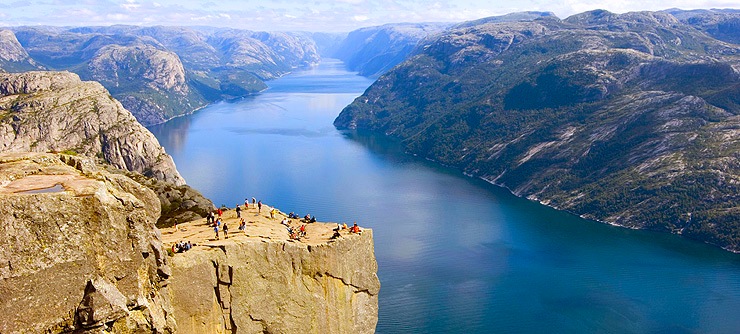 On our way back
to the ship, we came across a strawberry stand being
helmed by two girls of less than 10 years old. The
fruit was ripe and dense, stained our fingers a deep
crimson, and provided just the energy we needed to
make it back to the ship for a hearty lunch of fish
and chips in the Golden Lion Pub.
On our way back
to the ship, we came across a strawberry stand being
helmed by two girls of less than 10 years old. The
fruit was ripe and dense, stained our fingers a deep
crimson, and provided just the energy we needed to
make it back to the ship for a hearty lunch of fish
and chips in the Golden Lion Pub.
Our last port of call was
Stavanger, a town whose title as oil and gas capital
of Norway fails to do it justice. Indeed, in this
oil-rich country (it’s a major reason for its
continued wealth today), you’d assume that a town so
reliant on this industry would be some kind of
hardscrabble place, the streets dotted with the kind
of faceless buildings that blight industrial cities
all over the world.
But that’s not the case at all. Rather,
Stavanger has used its oil wealth--and, before that,
its success in sardine-canning--to create a city of
remarkable beauty. Sure, there are sections that are
less aesthetically appealing, but on the whole
Stavanger is a walking-friendly city of beguiling
streets and museums, of lovely public spaces and
quaint shops and cafes. 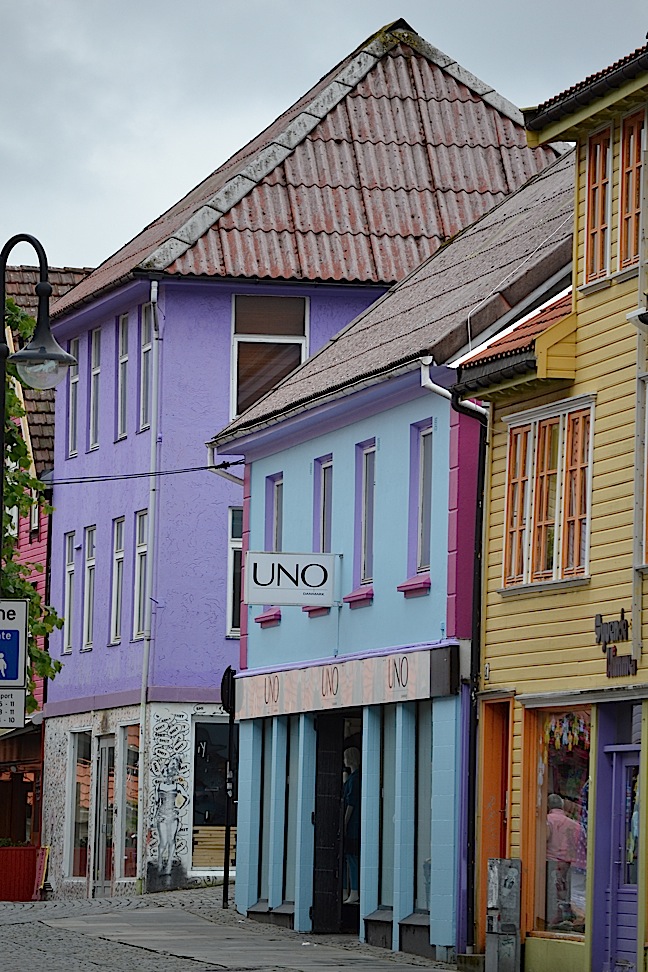
The only problem for visitors, really, is the cost of
living, as it is throughout the country. Indeed, the
strength of the kroner and the expense of everything
from coffee to salads means that you’re probably best
off simply doing what we did there: Avoid thinking
about the expense (how much
does that sandwich cost?) and just
enjoy. Wander the cobblestone streets, marvel at the
startlingly colorful buildings along Øvre
Holmegate, stop for an espresso at one of the many
cafes (Norwegian coffee, deeply acidic and
comfortingly roasty, is wonderful). Head to the
Canning Museum to learn about the city’s history in
the sardine industry. Wander in and out of small,
independently owned shops where the baby clothes are
designed in-house and sewn by hand, along streets
festooned with witty, well-considered art, up to the
playground constructed of old buoys that the kids leap
upon. This is an “oil city” unlike any you’ve ever
seen.
Most of the part of Norway that we explored, in
fact, is unlike anything I’d seen. It’s a part of
Europe that is too often missed by American tourists,
but one that should be on the bucket list of every
world traveler. And seeing it this way, as the Queen
Elizabeth traversed the sea and the fjords, was the
perfect way to do so. Not only were the ports of call
themselves astounding, but the journeys between them
were, too.
My only complaint was the difficulty of the
transition back to my normal life here in
Philadelphia. Somehow, the view from my window in Old
City, lovely as it is, pales in comparison to Norway
from the QE. And I won’t even address the air quality
here.
❖❖❖
NEW YORK
CORNER
by
John Mariani
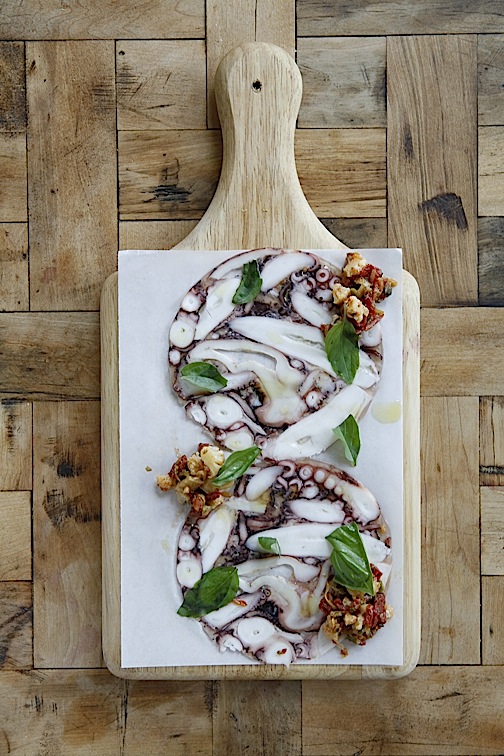 ROSEMARY'S
ROSEMARY'S
18
Greenwich Avenue (at West 10th Street)
212-647-1818
rosemarysnyc.com
The biggest success story of
the summer in terms of sheer buzz is Rosemary's, a
wide-open big 74-seat room with room for 40 at the
wine bar that could not be more packed to its pretty
rafters than it was from Day One. Its location is
prime; indeed the West Village is where a great deal
of exciting restaurant action is happening these days,
and, more important, has attracted a lot of veteran
restaurateurs whose track record in drawing crowds is
undeniable.
In the case of Rosemary’s owners, led by Carlos
Suarez, they also run the very popular Bobo in the
same neck of the woods, and Rosemary’s big open room
on one of the Village’s finest stretches of real
estate acts as a beacon of light and the sound of
people enjoying themselves. And while it can get
louder as the night progresses, from about 7 PM to 9
PM, it’s more than tolerable. And if you need a
breather, ask to see the rooftop garden that provides
Chef Wade Moises with a constant supply of fresh herbs
and vegetables.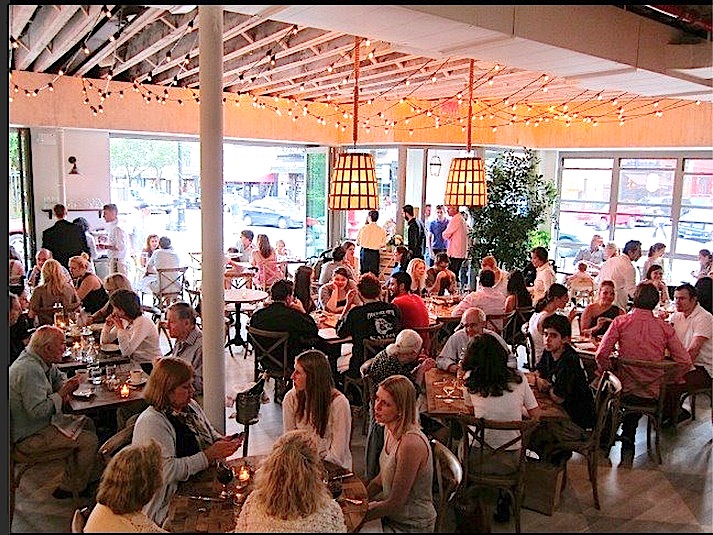
It’s a very attractive crowd, the kind
that makes its own scene, and in one sense, not taking
reservations for less than parties of six makes it a
more democratic venue than, say, Minetta Tavern; the
wait can be long if you just drop by, so go on the
early side or have a glass of wine or beer at the bar
(they serve no booze).
For a room this size and with this crowd,
the menu may be a tad long, but they keep the pastas
down to half a dozen, allowing the kitchen to make
them right and carefully to keep them al dente. You
might order a plate of vegetables, including a fine
eggplant caponata,
$5 each, three for $12 or for a table of four, five
for $20. There is also a selection of seafood
appetizers,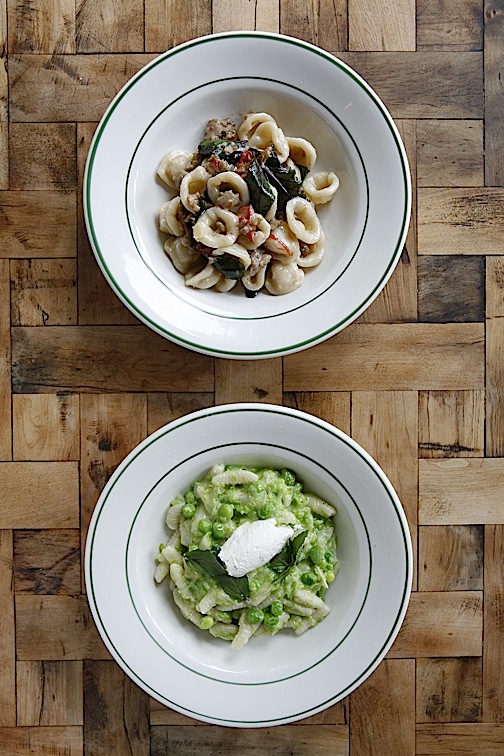 including a superb octopus salad (above) that is
tender, briny, sweet and sour. Calamari come with
celery, almonds, raisins and a dash of chili oil. Then there
is a selection of good salumi, two of them housemade—the
pork testa is
really good--and cheeses, including freshly made
ricotta. There are also four focacce, including Rosemary’s with,
of course, rosemary and olive oil, and one with strips
of lardo fat. The chopped
Siciliana salad is an excellent choice, with escarole,
artichoke, olives, and much more.
including a superb octopus salad (above) that is
tender, briny, sweet and sour. Calamari come with
celery, almonds, raisins and a dash of chili oil. Then there
is a selection of good salumi, two of them housemade—the
pork testa is
really good--and cheeses, including freshly made
ricotta. There are also four focacce, including Rosemary’s with,
of course, rosemary and olive oil, and one with strips
of lardo fat. The chopped
Siciliana salad is an excellent choice, with escarole,
artichoke, olives, and much more.
We come to the pastas—priced at a
remarkable $12-$14 at a time when most places are
charging $20 and up--and every one we tried was a
success and very correctly prepared, from a hearty chitarra alla carbonara
to a very fine cavatelli
with fresh mint, sweet peas, and ricotta (left)—two Roman
dishes. Orechiette came with
garlicky braised greens and housemade sausage, and the
big winner of the evening was linguini with preserved
lemon, pickled chile, and a dousing of Parmigiano.
Moises
worked at Babbo and Lupa, so he’s very good at getting
the lusty, rustic flavors of the trattoria right. That means
the porchettina with
fennel and mostarda
will be juicy and nicely seasoned, the skirt steak
well textured, with crispy potatoes and balsamico, and
the fish of the day expertly grilled, with radish
tops, snap
peas, and cherry tomatoes.
The desserts are good if not out of the
ordinary, the
usual hazelnut semifreddo and tiramisu. The basic wine list is
solid, with plenty of bottles under $50, but some of
them are way too pricey. The reserve list
heads into the stratosphere.
Rosemary’s is the kind of trattoria NYC
can never have enough of, despite the scene seemingly
being sated with them.
If the no-rez policy is a problem (and it
definitely can be), go for lunch or brunch, but do go
and get into the swing of things. You’ll have
fun.
Rosemary’s is open for lunch,
Mon.-Fri., for brunch Sat. & Sun., and for
dinner nightly. Appetizers run $5-$14, pastas
$12-$14, main courses $18-$24.
❖❖❖
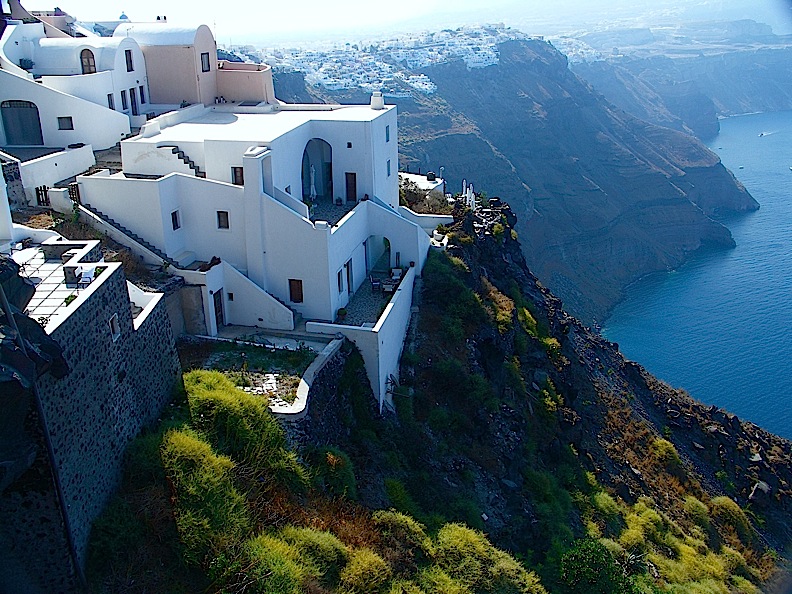
There
are worse ways to spend your euros than sitting at a
taverna on the Greek island of Santorini (above) when the
dry northern meltemi
wind blows though the Aegean in August.
Feasting on white eggplant and feta
cheese and grilled barbouni
(red mullet) while sipping a white assyrtiko wine made
on the island (where a glass of orange juice can cost
$12) and looking down at the yachts in the harbor
below, I found it difficult to imagine the Greek
economy is in a shambles. But as the economy worsens
here, the wines only get better. Maybe drinking wine
helps.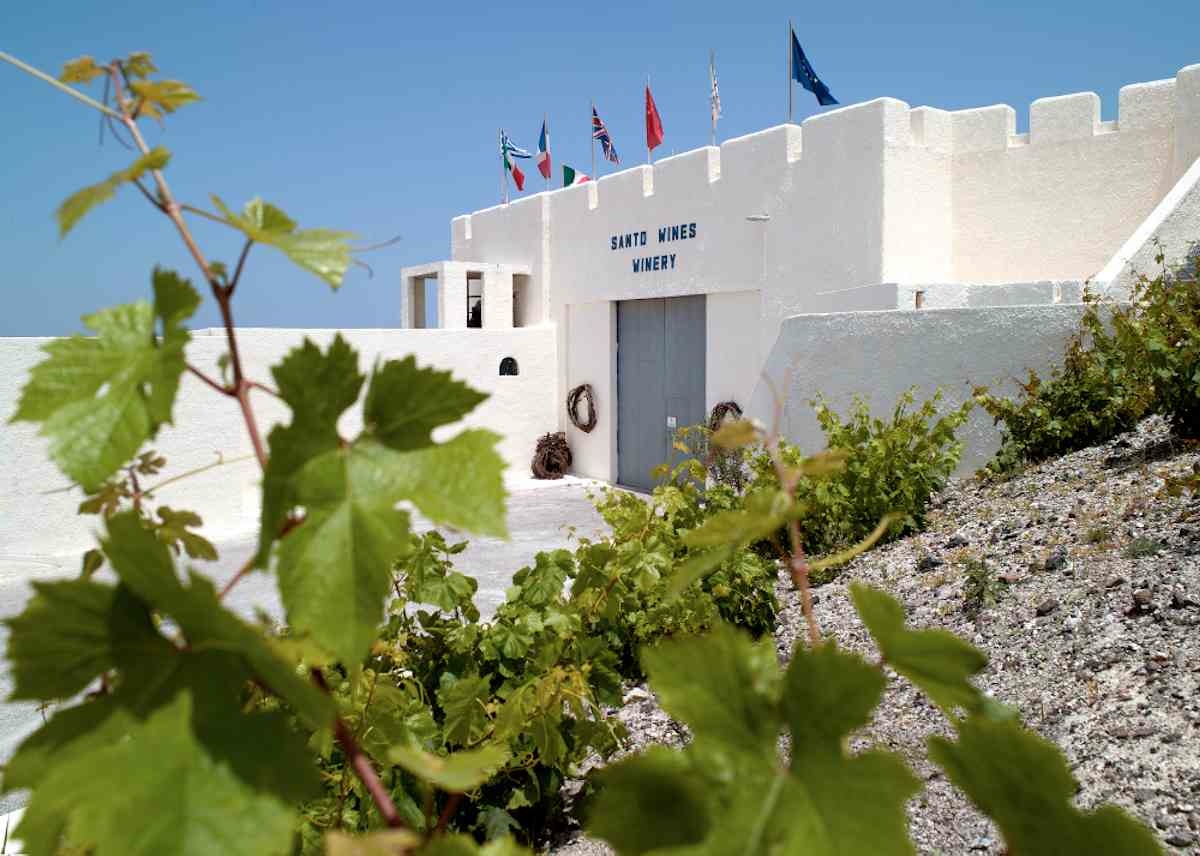
On Santorini alone, which is only 28 square miles in
size, there are 13 core wineries, most notably Boutari
in Megalochori, which produces about 900,000 bottles a
year there, mostly from imported grapes. The
indigenous grape vines were never affected by the
phylloxera plague that ruined European vineyards, but
there are not enough even to satisfy local
consumption.
The story of Greek wine is ancient
but, until recently, not very illustrious—one reason
the ancient Greeks were delirious to make settlements
in Italy, which they called Enotria, ”wine land.” Once
known primarily for its resinous wines and ouzo,
Greece has now put a great deal of effort and capital
into capturing some of the global market, as well as
planting international varietals like chardonnay and
cabernet sauvignon aimed at Greece’s young
winedrinkers.
According to George Athanas, manager of the All About
Greek Wine promotional campaign on behalf of the Greek
government’s New Wines of Greece bureau, between 3.5
and 4 million hectoliters of wine are now made
annually, 60 percent consumed in bulk domestically.
Although total exports have slipped by almost half
from a high point of 787 hectoliters in 2002, exports
to the U.S. brought in 6.3 Euros last year, an
increase of a million Euros over the last decade.
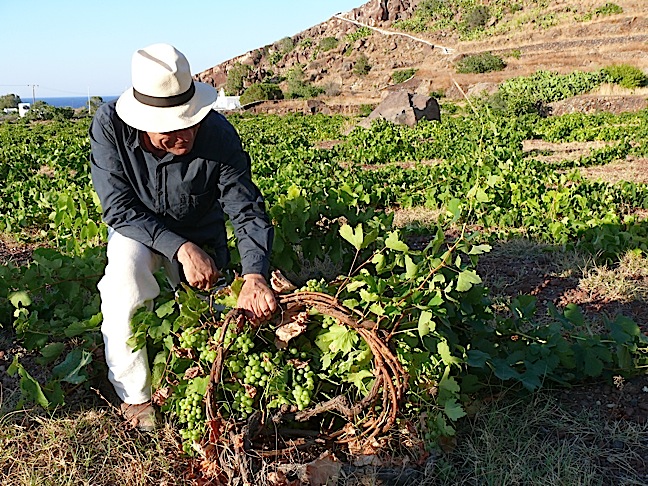 The reason,
says Athanas, is that “Greece is making a major effort
in the U.S. market for younger wine drinkers more
willing to try new things. Greece is promoting its
best wines and aren't sending the kind of oxidized
schlock they did in the past.”
The reason,
says Athanas, is that “Greece is making a major effort
in the U.S. market for younger wine drinkers more
willing to try new things. Greece is promoting its
best wines and aren't sending the kind of oxidized
schlock they did in the past.”
Of these last I am not much impressed: the
international varietals don’t taste much like the
grape, and if blended with Greek grapes, tend to mask
the character of the indigenous grapes.
Sampling an array of whites and reds I bought at Grand
Wine and Liquor, I found all of them clean and well
made, none showing the slightest oxidation. 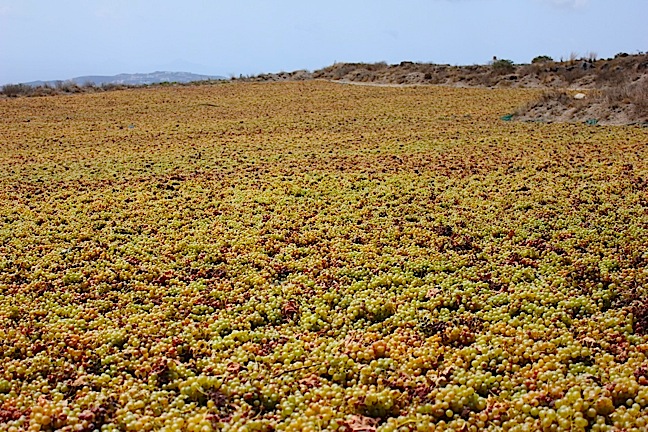 I
expected the whites to be good but was really
delighted with the new reds. Of the former, the Tareti 2010 from
Ktima Biblia Chora ($30) had the characteristics
of modern assyrtiko, a varietal that originated on
Santorini, showing its brisk minerality and acid that
allows it to age beyond most white wines’ peak.
I
expected the whites to be good but was really
delighted with the new reds. Of the former, the Tareti 2010 from
Ktima Biblia Chora ($30) had the characteristics
of modern assyrtiko, a varietal that originated on
Santorini, showing its brisk minerality and acid that
allows it to age beyond most white wines’ peak.
For something more floral, and aromatic, try the Alpha Estate
Axia 2011 ($18) made from malagouzia grapes, an
ancient varietal now enjoying renewed interest for its
full body and richness.
True
to form, the moschofilero varietal shows its
brassy-pink color and complexity in Domaine
Spiropoulos 2010 ($15), made from organic grapes, an
excellent wine with all seafood or Greek mezes
appetizers.
Two
reds were outstanding: Saint George
Aghiorghitiko 2010, which Homer might have had
in mind when he wrote of the “wine dark sea” and Zorba
the Greek meant when he said, “You drink the big red
wine and, lo and behold your soul grows big . . . and
challenges God to a fight.” It comes from southern
mountain vineyards and has the tannins and complexity
you rarely get in $15 red wines.
As for the curiously named Red Stag 2009 ($15) from the producer Spiropoulas, Cary Grant might exclaim, “Juicy! Juicy! Juicy!” At just 13 percent alcohol it manages to carry both power and voluptuous fruit in an ideal balance based on the agiorgitiko grapes grown in Nemea.
❖❖❖
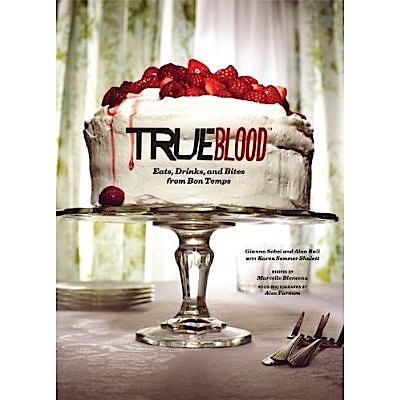 DRINK
YOUR SOUP BEFORE IT CLOTS!
DRINK
YOUR SOUP BEFORE IT CLOTS!
by Gianna Sobol, Alan Ball and Karen Shalett
has just been published, with dishes like
"Stake and Eggs" and "Another Dead Chick-en Sandwich."
AND
THEY DON'T HAVE TO BE TOLD
TO WASH THEIR HANDS!
To cut his labor costs, Chinese restaurateur Cui
Runguan is selling robots called the Chef Cui. that can hand slice
noodles into a pot of boiling water,
costing $2,000
each, as compared to a chef, who would cost
$4,700 a year. Watch the video:
http://eater.com/archives/2012/08/17/china-is-building-an-army-of-noodle-making-robots.php#more
❖❖❖
Any of John Mariani's
books below may be ordered from amazon.com.
 |
My latest book, which just won the prize for best book from International Gourmand, written with Jim Heimann and Steven Heller, Menu Design in America, 1850-1985 (Taschen Books), has just appeared, with nearly 1,000 beautiful, historic, hilarious, sometimes shocking menus dating back to before the Civil War and going through the Gilded Age, the Jazz Age, the Depression, the nightclub era of the 1930s and 1940s, the Space Age era, and the age when menus were a form of advertising in innovative explosions of color and modern design. The book is a chronicle of changing tastes and mores and says as much about America as about its food and drink.
“Luxuriating vicariously in the pleasures of this book. . . you can’t help but become hungry. . .for the food of course, but also for something more: the bygone days of our country’s splendidly rich and complex past. Epicureans of both good food and artful design will do well to make it their coffee table’s main course.”—Chip Kidd, Wall Street Journal.
“[The menus] reflect the amazing craftsmanship that many restaurants applied to their bills of fare, and suggest that today’s restaurateurs could learn a lot from their predecessors.”—Rebecca Marx, The Village Voice. |
"Eating Italian will never be the same after reading John Mariani's entertaining and savory gastronomical history of the cuisine of Italy and how it won over appetites worldwide. . . . This book is such a tasteful narrative that it will literally make you hungry for Italian food and arouse your appetite for gastronomical history."--Don Oldenburg, USA Today. "Italian
restaurants--some good, some glitzy--far
outnumber their French rivals. Many of
these establishments are zestfully described
in How Italian Food Conquered the World, an
entertaining and fact-filled chronicle by
food-and-wine correspondent John F.
Mariani."--Aram Bakshian Jr., Wall Street
Journal.
"Equal parts
history, sociology, gastronomy, and just
plain fun, How Italian Food Conquered the
World tells the captivating and delicious
story of the (let's face it) everybody's
favorite cuisine with clarity, verve and
more than one surprise."--Colman Andrews,
editorial director of The Daily
Meal.com. "A fantastic and fascinating
read, covering everything from the influence
of Venice's spice trade to the impact of
Italian immigrants in America and the
evolution of alta cucina. This book will
serve as a terrific resource to anyone
interested in the real story of Italian
food."--Mary Ann Esposito, host of PBS-TV's
Ciao
Italia. "John Mariani has written the
definitive history of how Italians won their
way into our hearts, minds, and
stomachs. It's a story of pleasure over
pomp and taste over technique."--Danny Meyer,
owner of NYC restaurants Union Square Cafe,
Gotham Bar & Grill, The Modern, and
Maialino.
|
 |
 |
 |
 |
 |
 |
 |
 |
 Everett Potter's Travel Report:
Everett Potter's Travel Report: 
 Eating Las Vegas
is the new on-line site for Virtual Gourmet
contributor John A. Curtas., who since 1995
has been commenting on the Las Vegas food
scene and reviewing restaurants for Nevada
Public Radio. He is also the
restaurant critic for KLAS TV, Channel 8 in
Las Vegas, and his past reviews can be
accessed at KNPR.org.
Click on the logo below to go directly to
his site.
Eating Las Vegas
is the new on-line site for Virtual Gourmet
contributor John A. Curtas., who since 1995
has been commenting on the Las Vegas food
scene and reviewing restaurants for Nevada
Public Radio. He is also the
restaurant critic for KLAS TV, Channel 8 in
Las Vegas, and his past reviews can be
accessed at KNPR.org.
Click on the logo below to go directly to
his site.

Tennis Resorts Online: A Critical Guide to the World's Best Tennis Resorts and Tennis Camps, published by ROGER COX, who has spent more than two decades writing about tennis travel, including a 17-year stretch for Tennis magazine. He has also written for Arthur Frommer's Budget Travel, New York Magazine, Travel & Leisure, Esquire, Money, USTA Magazine, Men's Journal, and The Robb Report. He has authored two books-The World's Best Tennis Vacations (Stephen Greene Press/Viking Penguin, 1990) and The Best Places to Stay in the Rockies (Houghton Mifflin, 1992 & 1994), and the Melbourne (Australia) chapter to the Wall Street Journal Business Guide to Cities of the Pacific Rim (Fodor's Travel Guides, 1991).


MARIANI'S VIRTUAL GOURMET
NEWSLETTER is published weekly. Editor/Publisher: John
Mariani.
Contributing Writers: Christopher Mariani, Robert Mariani,
John A. Curtas, Edward Brivio, Mort Hochstein,
Suzanne Wright, and Brian Freedman. Contributing
Photographers: Galina Stepanoff-Dargery,
Bobby Pirillo. Technical Advisor: Gerry McLoughlin.
To un-subscribe from this newsletter,click here.
© copyright John Mariani 2012
